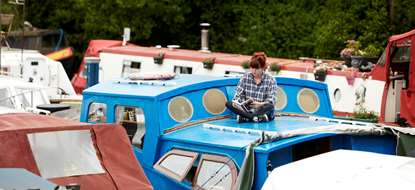First time buyers guide
What is a narrowboat?
Thinking about buying a narrowboat? Exciting! Our guide covers everything you need to know, from making a smart purchase to maintaining and securing your new home on the water.
A narrowboat is officially defined by its width, or beam, of 6ft 10in to 7ft. In contrast, barges are about twice as wide, around 14.5 ft. Between these, you'll find 'wide beam' canal boats.
Narrowboats are the most common vessels on UK canals and are popular for living aboard. They can be up to 70ft long, as this is the maximum length for the UK's longest locks. For leisure use, a 30-40ft boat is usually sufficient, while a 50ft boat is ideal for living.
How to buy a narrowboat
Choosing your dream narrowboat involves more than just picking a vessel. Consider ongoing costs like mooring and license fees. Here are some key questions to ask yourself:
- How much space do you need?
- Will you live on the boat full-time?
- Are you interested in a restoration project or a ready-to-go boat?
Buying a narrowboat checklist
General Maintenance: Check the boat's condition, including paintwork, varnishing, and onboard equipment. Ensure the fridge, cooker, heating system, and shower are in good working order. Look for central, fore, and aft ropes for easy mooring, a windlass (lock key), and mooring pins.
Hull Condition: Verify the hull meets the traditional 10/6/4mm steel thickness specification (10mm base, 6mm sides, 4mm roof). Ask when the boat was last 'blacked' (dry docked, pressure washed, and protected with bitumen), which should be done every 2-3 years.
Engine and Gearbox: Inspect the engine and gearbox for leaks. Water-cooled diesel engines are common on newer boats, while older ones may have noisier air-cooled engines.
Batteries: Standard narrowboats have three leisure batteries and one starter battery. Check for a battery management system and an inverter to convert 12-volt battery power to 240 volts.
Survey: Have a qualified marine surveyor inspect the boat for any issues with the hull and internal systems.
The costs of living on a narrowboat
In addition to the boat itself, consider these ongoing costs:
Canal and River Trust Licenses: Varies by boat size; a 40ft vessel costs about £700 per year.
Boat Safety Scheme: Like an MOT for your boat, costing around £87.50 annually.
Council Tax: Usually the lowest band if moored permanently. Continuous cruisers who move every two weeks typically don't pay this.
Mooring Fees: Range from £3,000 to £18,000 annually, depending on location.
Fuel and Heating: Costs depend on travel frequency and personal comfort needs.
Insurance: Varies based on coverage needs.
Read more on the monthly costs of living onboard a narrowboat.
Canal boat maintenance
Regular maintenance keeps your narrowboat in top shape. Here's a basic schedule:
Daily: Check oil level, engine coolant level, and bilge level.
Monthly: Inspect engines and drive belts, exhaust leaks, gas flame colour, and mooring ropes.
Seasonal Start: Align the engine, check fan belts, renew fuel filters, clean air filters, and change gearbox oil.
Seasonal End: Monitor antifreeze levels and heater performance.
Narrowboat security
Keep your narrowboat secure with these tips:
Moorings: Use gated marinas if possible, or take extra precautions if living along the canal.
Contents: Keep valuables out of sight and secure items like anchors and gas bottles.
Doors and Windows: Reinforce with extra locks, clasps, and bars.
Alarm Systems: Consider motion sensors or CCTV.
Locking Fuel Cap: Prevent fuel theft with a lockable filler cap.




